Module 6 Animals in Danger Reading课件(20张PPT)
文档属性
| 名称 | Module 6 Animals in Danger Reading课件(20张PPT) |  | |
| 格式 | zip | ||
| 文件大小 | 719.3KB | ||
| 资源类型 | 教案 | ||
| 版本资源 | 外研版 | ||
| 科目 | 英语 | ||
| 更新时间 | 2019-08-18 22:34:08 | ||
图片预览

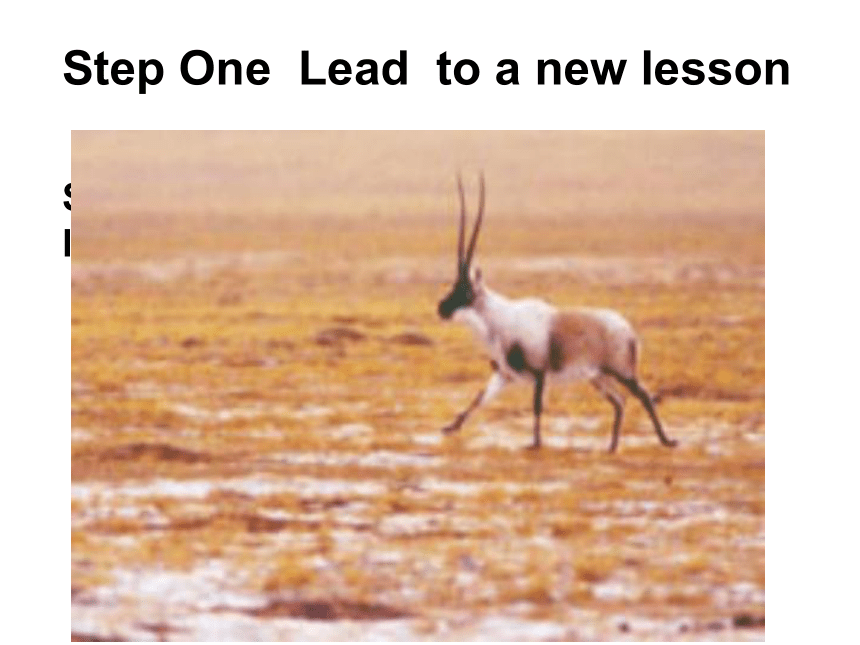
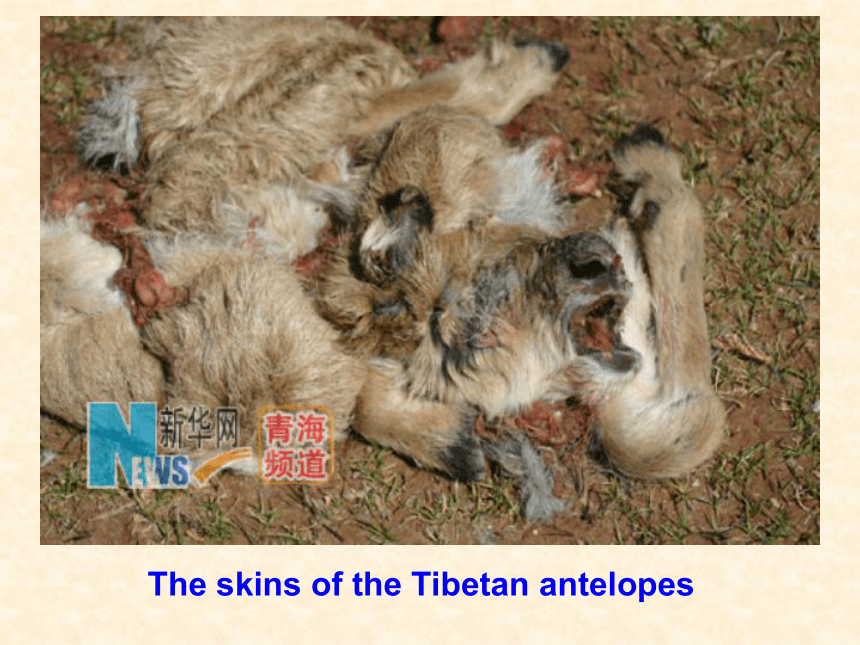
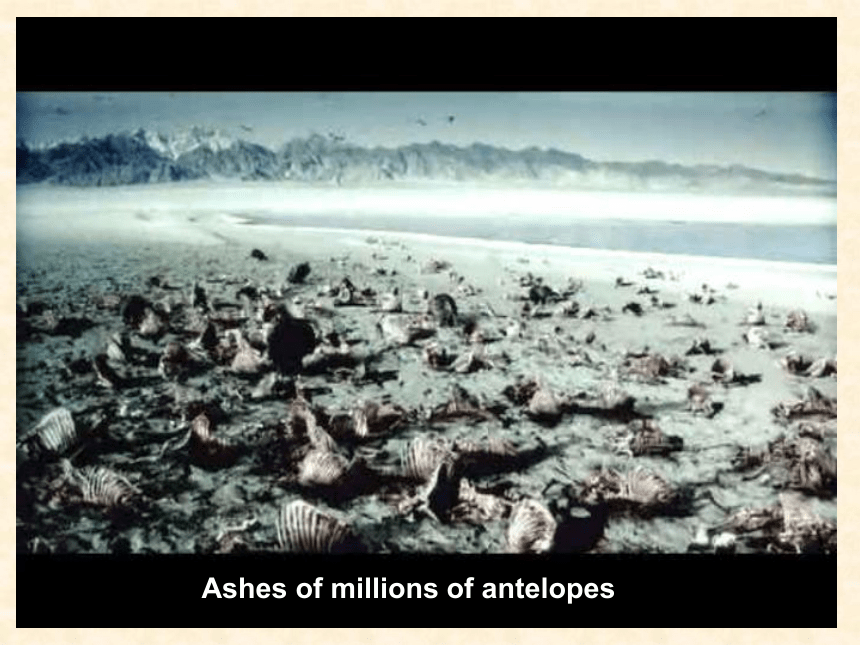
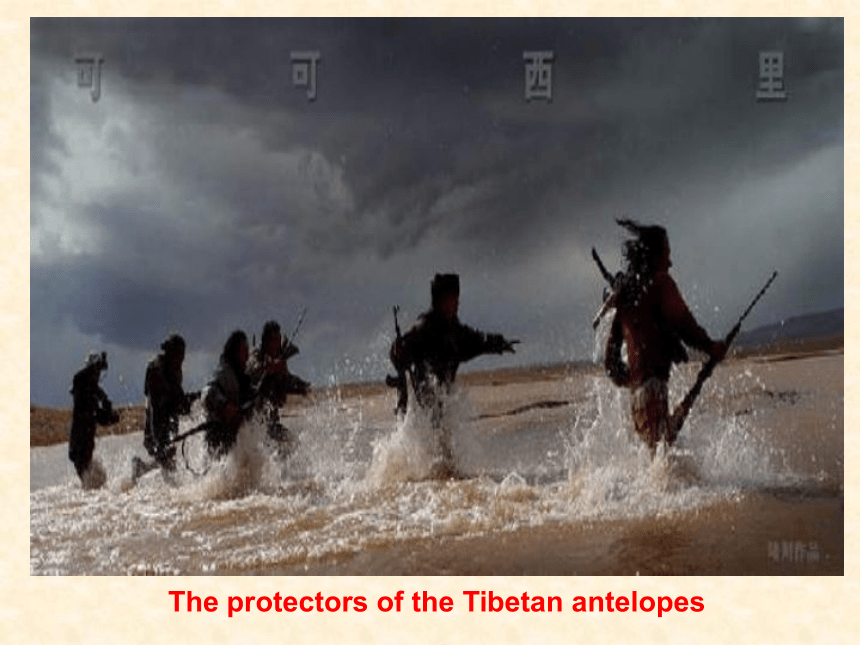
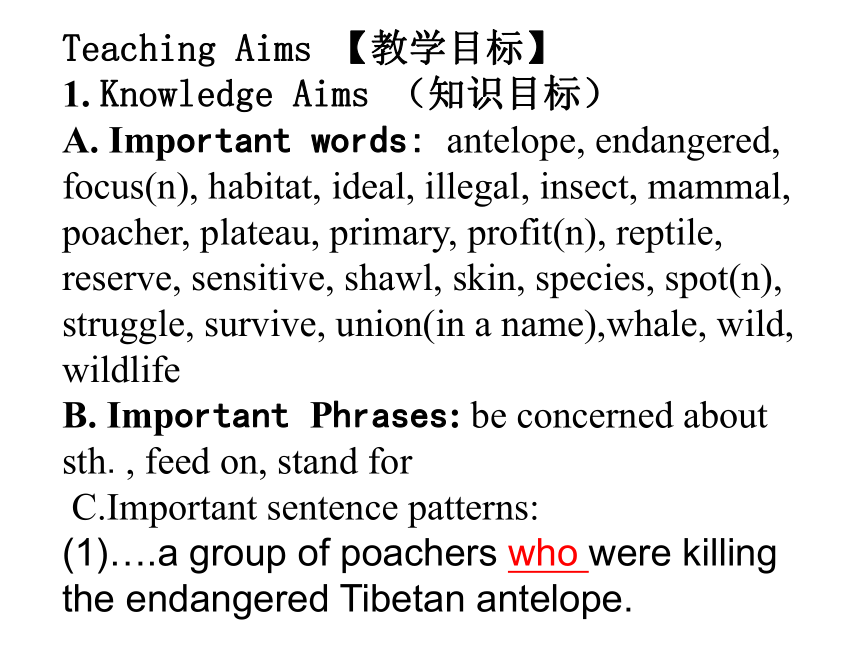
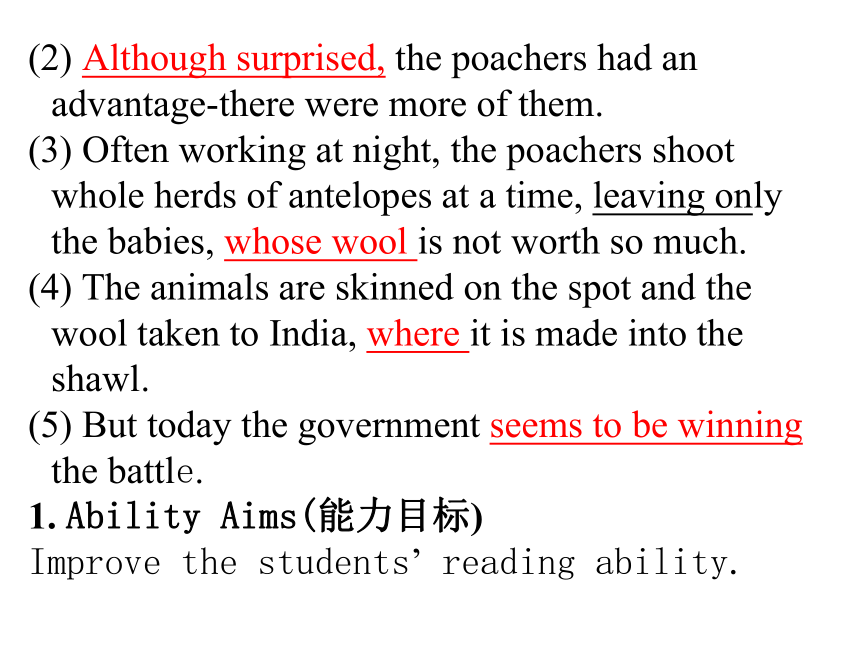
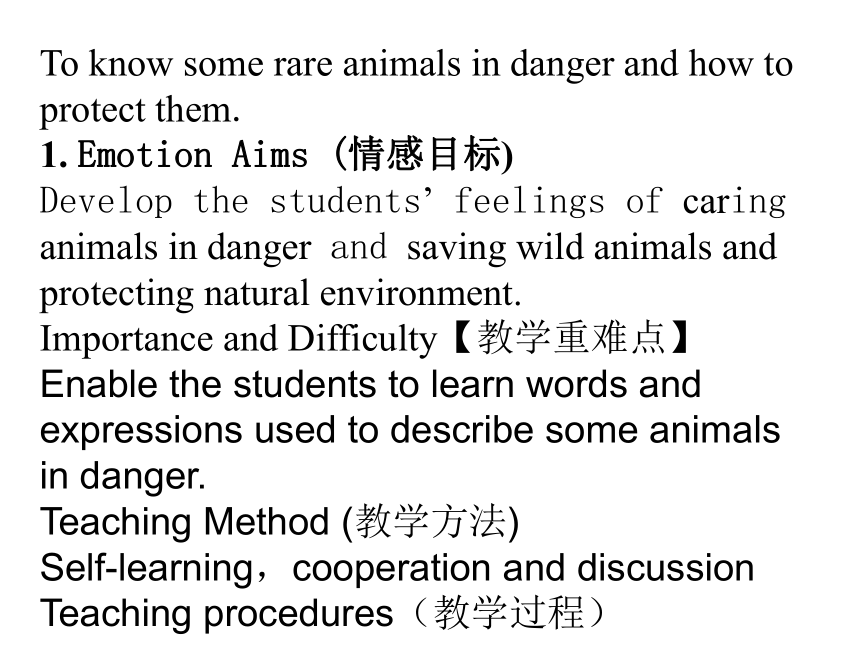

文档简介
课件20张PPT。 Saving the Antelopesto our classStep One Lead to a new lesson
Show some pictures to students and lead to a new lesson
The skins of the Tibetan antelopesAshes of millions of antelopesThe protectors of the Tibetan antelopesTeaching Aims 【教学目标】
1. Knowledge Aims (知识目标)
A. Important words: antelope, endangered, focus(n), habitat, ideal, illegal, insect, mammal, poacher, plateau, primary, profit(n), reptile, reserve, sensitive, shawl, skin, species, spot(n), struggle, survive, union(in a name),whale, wild, wildlife
B. Important Phrases: be concerned about sth., feed on, stand for
C.Important sentence patterns:
(1)….a group of poachers who were killing the endangered Tibetan antelope.(2) Although surprised, the poachers had an advantage-there were more of them.
(3) Often working at night, the poachers shoot whole herds of antelopes at a time, leaving only the babies, whose wool is not worth so much.
(4) The animals are skinned on the spot and the wool taken to India, where it is made into the shawl.
(5) But today the government seems to be winning the battle.
1. Ability Aims(能力目标)
Improve the students’ reading ability.
To know some rare animals in danger and how to protect them.
1. Emotion Aims (情感目标)
Develop the students’ feelings of caring animals in danger and saving wild animals and protecting natural environment.
Importance and Difficulty【教学重难点】
Enable the students to learn words and expressions used to describe some animals in danger.
Teaching Method (教学方法)
Self-learning,cooperation and discussion
Teaching procedures(教学过程)Step Two Pre-reading
(Predicting):
What the passages is about ?The struggles between the protectors and poachersMany protectors died for protecting the Tibetan antelopesStep Three : While Reading(skimming and scanning) .PARA 1Read the text quickly and match the main idea witheach paragraph.PARA 5PARA 2PARA 3PARA 4A:Reasons for killings
B:Jiesang Suonandajie’s Death
C:Progress(进展) in protecting
D:Government’s measure(措施) E:The bussiness of antelope wool
Step Four Careful reading (Group Work)What do these numbers and dates refer to?Fill in the chartJiesang SuonandajiepoachersnumbershawlbankilledgrowvolunteersraidStep Five:Testing in Class and
Improvement
Retelling the passage according to the
content of text with some key words.
Cloze testCloze test At the beginning of the twentieth century there were millions of antelopes on the Qinghai-Tibetan Plateau. By the 1990s the number ____ ____ to about 50,000.the reason is that the of the Tibetan antelope is the very expensive A shawl ____ ____the wool can sell for $5,000.
The business is completely _____-there has been a on the trade since 1975. But in the 1990s the shawls ____ ___ ______among rich people. A police on a shop found 138 shawls. About 1,000 antelopes – or 2% of the world’s population- had been killed to make them.
The Chinese government began to ___ __ ____ ____ in protecting the antelopes .Over the next ten years about 3,000 poachers were caught and 300 vehicles _________.
, in those countries where the shawls are sold, police are getting with the dealers. International co-operation seems to be . Since 1997 the antelope population has slowly begun to ____again.illegalconfiscatedgrowMeanwhiletoughworkingwool banraidStep Six Homework
writing practice
Topic: endangered Animals
key words: (1). endanger (2). poachers (3). profit (4). destroy (5). habitat
(6). number… fall
(7). take measures to …
(8). pass laws
(9). get tough with (10). volunteer
(11). remind
3.structure: introduction present situation
body : analyse the reasons
solutions to the problems
conclusion: conclusion
Step Seven Summary 【总结】
(方法引导:总结归纳你们学到的东西,必要的时候,可以将你学到的东西跟你的同学交流分享,比如互相提问、听写、默写等等)
Reflection:(课后反思)THANKS A LOT!
Saving the antelopes
On a freezing cold day in January 1994, Jiesang Suonandajie found what he was looking for a group of poachers who were killing the endangered Tibetan antelope.Jiesang knew he had to move quickly. He shouted to the poachers to put down their guns. Although surprised, the poachers had an advantage-there were more of them. In the battle which followed Jiesang was shot and killed. When his frozen body was found hours later, he was still holding his gun. He had given his life to save the Tibetan antelope.
At the beginning of the twentieth century there were millions of antelopes on the Qinghai-Tibetan Plateau. By the 1990s the number had fallen to about 50,000. The reason is the most expensive in the world. It is soft, light, and warm- the ideal coat for an animal which has to survive at high altitudes. A shawl made from the wool(known as "shahtoosh", or "king of wools" in Persian)can sell for five thousand dollars. For poachers the profits can be huge.
Often working at night, the poachers shoot whole herds of antelopes at a time, leaving only the babies, whose wool is not worth so much. The animals are skinned on the spot and the wool taken to India, where it is made into the shawls. From there, it is exported to rich countries in North America and Europe. The business is completely illegal—there has been a ban on the trade since 1975.But in the 1990s the shawls came into fashion among rich people. A police raid on a shop in London found 138 shawls. About 1,000 antelopes—or 2 per cent of the world's population—had been killed to make them.
In the 1990s the Chinese government began to take an active part in protecting the antelopes in the Hoh Ail Nature Reserve—the huge national park on the Qinghai-Tibetan Plateau, which is the main habit of the antelopes. Over the next ten years about 3,000 poachers were caught and 300 vehicles confiscated. Sometimes there were gunfights, like the one in which Jessing Suonandajie was killed.
But today the government seems to be winning the battle. The number of poachers has fallen. The small group of officials who work in the reserve are helped by volunteers who come from all over the country, and who are ready for the difficult conditions of life at 5,000 metres. Meanwhile, in those countries where the shawls are sold, police are getting tough with the dealers. International co-operation seems to be working. Since 1997 the antelope population has slowly begun to grow again.
Show some pictures to students and lead to a new lesson
The skins of the Tibetan antelopesAshes of millions of antelopesThe protectors of the Tibetan antelopesTeaching Aims 【教学目标】
1. Knowledge Aims (知识目标)
A. Important words: antelope, endangered, focus(n), habitat, ideal, illegal, insect, mammal, poacher, plateau, primary, profit(n), reptile, reserve, sensitive, shawl, skin, species, spot(n), struggle, survive, union(in a name),whale, wild, wildlife
B. Important Phrases: be concerned about sth., feed on, stand for
C.Important sentence patterns:
(1)….a group of poachers who were killing the endangered Tibetan antelope.(2) Although surprised, the poachers had an advantage-there were more of them.
(3) Often working at night, the poachers shoot whole herds of antelopes at a time, leaving only the babies, whose wool is not worth so much.
(4) The animals are skinned on the spot and the wool taken to India, where it is made into the shawl.
(5) But today the government seems to be winning the battle.
1. Ability Aims(能力目标)
Improve the students’ reading ability.
To know some rare animals in danger and how to protect them.
1. Emotion Aims (情感目标)
Develop the students’ feelings of caring animals in danger and saving wild animals and protecting natural environment.
Importance and Difficulty【教学重难点】
Enable the students to learn words and expressions used to describe some animals in danger.
Teaching Method (教学方法)
Self-learning,cooperation and discussion
Teaching procedures(教学过程)Step Two Pre-reading
(Predicting):
What the passages is about ?The struggles between the protectors and poachersMany protectors died for protecting the Tibetan antelopesStep Three : While Reading(skimming and scanning) .PARA 1Read the text quickly and match the main idea witheach paragraph.PARA 5PARA 2PARA 3PARA 4A:Reasons for killings
B:Jiesang Suonandajie’s Death
C:Progress(进展) in protecting
D:Government’s measure(措施) E:The bussiness of antelope wool
Step Four Careful reading (Group Work)What do these numbers and dates refer to?Fill in the chartJiesang SuonandajiepoachersnumbershawlbankilledgrowvolunteersraidStep Five:Testing in Class and
Improvement
Retelling the passage according to the
content of text with some key words.
Cloze testCloze test At the beginning of the twentieth century there were millions of antelopes on the Qinghai-Tibetan Plateau. By the 1990s the number ____ ____ to about 50,000.the reason is that the of the Tibetan antelope is the very expensive A shawl ____ ____the wool can sell for $5,000.
The business is completely _____-there has been a on the trade since 1975. But in the 1990s the shawls ____ ___ ______among rich people. A police on a shop found 138 shawls. About 1,000 antelopes – or 2% of the world’s population- had been killed to make them.
The Chinese government began to ___ __ ____ ____ in protecting the antelopes .Over the next ten years about 3,000 poachers were caught and 300 vehicles _________.
, in those countries where the shawls are sold, police are getting with the dealers. International co-operation seems to be . Since 1997 the antelope population has slowly begun to ____again.illegalconfiscatedgrowMeanwhiletoughworkingwool banraidStep Six Homework
writing practice
Topic: endangered Animals
key words: (1). endanger (2). poachers (3). profit (4). destroy (5). habitat
(6). number… fall
(7). take measures to …
(8). pass laws
(9). get tough with (10). volunteer
(11). remind
3.structure: introduction present situation
body : analyse the reasons
solutions to the problems
conclusion: conclusion
Step Seven Summary 【总结】
(方法引导:总结归纳你们学到的东西,必要的时候,可以将你学到的东西跟你的同学交流分享,比如互相提问、听写、默写等等)
Reflection:(课后反思)THANKS A LOT!
Saving the antelopes
On a freezing cold day in January 1994, Jiesang Suonandajie found what he was looking for a group of poachers who were killing the endangered Tibetan antelope.Jiesang knew he had to move quickly. He shouted to the poachers to put down their guns. Although surprised, the poachers had an advantage-there were more of them. In the battle which followed Jiesang was shot and killed. When his frozen body was found hours later, he was still holding his gun. He had given his life to save the Tibetan antelope.
At the beginning of the twentieth century there were millions of antelopes on the Qinghai-Tibetan Plateau. By the 1990s the number had fallen to about 50,000. The reason is the most expensive in the world. It is soft, light, and warm- the ideal coat for an animal which has to survive at high altitudes. A shawl made from the wool(known as "shahtoosh", or "king of wools" in Persian)can sell for five thousand dollars. For poachers the profits can be huge.
Often working at night, the poachers shoot whole herds of antelopes at a time, leaving only the babies, whose wool is not worth so much. The animals are skinned on the spot and the wool taken to India, where it is made into the shawls. From there, it is exported to rich countries in North America and Europe. The business is completely illegal—there has been a ban on the trade since 1975.But in the 1990s the shawls came into fashion among rich people. A police raid on a shop in London found 138 shawls. About 1,000 antelopes—or 2 per cent of the world's population—had been killed to make them.
In the 1990s the Chinese government began to take an active part in protecting the antelopes in the Hoh Ail Nature Reserve—the huge national park on the Qinghai-Tibetan Plateau, which is the main habit of the antelopes. Over the next ten years about 3,000 poachers were caught and 300 vehicles confiscated. Sometimes there were gunfights, like the one in which Jessing Suonandajie was killed.
But today the government seems to be winning the battle. The number of poachers has fallen. The small group of officials who work in the reserve are helped by volunteers who come from all over the country, and who are ready for the difficult conditions of life at 5,000 metres. Meanwhile, in those countries where the shawls are sold, police are getting tough with the dealers. International co-operation seems to be working. Since 1997 the antelope population has slowly begun to grow again.
